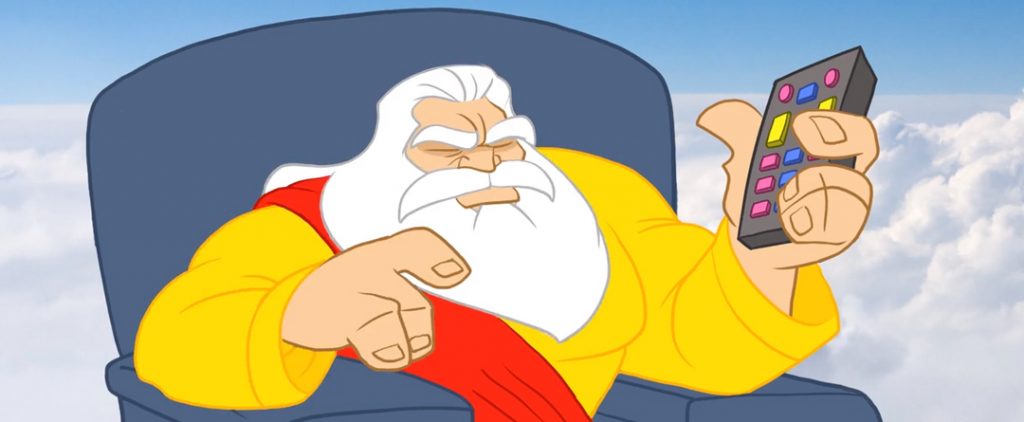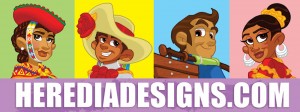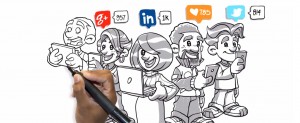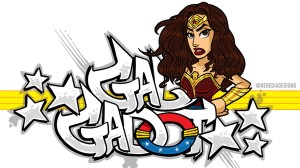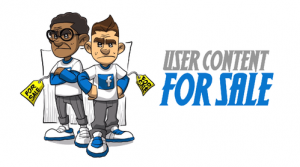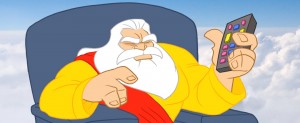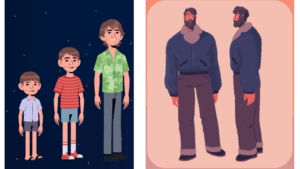In this week’s installment, we speak with (animation) hero of color David Heredia…
Last week we raved about a wonderful, dynamic and educational series called Heroes of Color. As we noted in our PICK OF THE WEEK blog post, this was the second episode of the series. So it felt fitting for us to bring back its creator, the great David Heredia, for a second interview. This time we dug deep into his graffiti-filled background and discussed how he got into (and then out of, and then back into again) animation. And, along the way, Heredia delighted us with insights and anecdotes of inspiration.
Blake J. Harris: David, thank you so much for chatting with us again!
David Heredia: I’m honored. Thank you so much for your review last week.
Blake J. Harris: Of course! So last time I interviewed you, we spoke about Heroes of Color. We talked about the origins of that series and some of the highlights. This time I wanted to talk more about you; your background, how you got into the animation business and some anecdotes from along the way.
David Heredia: Absolutely.
Blake J. Harris: Excellent. Tell me a bit about how you first got into illustration and animation.
David Heredia: I was born and raised in New York. Elementary school all the way straight up to my college. And junior high school was really when is started to take an interest in art. In the 7th grade there was an art contest that my school district was having, that Channel 13 was sponsoring. The contest was called “Racial Harmony,” and based just on that title you had to come up with a piece that, you know, showed harmony between different races. So all of the schools in that district had to design something. There were a lot of kids. And would you believe that I actually entered this contest and won? It blew me away.
Blake J. Harris: That’s amazing. What was your winning entry.?
David Heredia: You ready for this? My entry had a line of different people from different cultures all smiling, all holding food. They were on the welfare line picking up their government issued food. That was my racial harmony piece. And it won. Go figure.
David Heredia: Channel 13 had an award ceremony and the piece aired on TV. I got a certificate and everything; it was a really big deal. So that sort of put the confidence in me. Got me thinking: maybe I can do this. Not necessarily for a living, but I could continue doing this. And then the next year the school asked me to design the yearbook cover.
Blake J. Harris: Huge honor.
David Heredia: Yeah, so a lot of little things started to happen. And by the time I got to high school, one of my instructors suggested that I really look into attending the High School of Art of Design. Really great school with strong programs, so I did, I applied and I ended up going to the High School of Art and Design.
Blake J. Harris: What did you study there?
David Heredia: My major was cartooning, but I think what I learned more than anything was graffiti.
Blake J. Harris: How did that happen?
David Heredia: Like 90% of the students in that school wrote graffiti, so you couldn’t help but start to pick up certain attributes of graffiti. But I learned how to make it beneficial to my current artwork, you know?
Blake J. Harris: That’s really interesting. And now that you mention it, I can absolutely see that influence in your work. How long did you focus on that?
Blake J. Harris: How long did you focus on that?
David Heredia: My graffiti career only lasted about a year. After that, I realized that I just didn’t have the stomach for it. To be running from cops. I didn’t want a criminal record. So I gave up writing on walls. It definitely influenced my style, so I’m grateful for that aspect of it. After High School I went to NYC Tech for two years, and majored in advertising.
Blake J. Harris: You majored in advertising? How did you go from that into (or back to) animation?
David Heredia: After City Tech, I went to School of Visual Arts and I majored in Animation. So that’s really where my interest in animation came from. After that, I moved out to California and I worked at Disney for four years, but I was was not hired as an animator. I had applied to a ton of animation and storyboarding jobs, but I didn’t get any of them.
Blake J. Harris: How did you end up getting into whiteboard animation?
David Heredia: The whiteboard thing came about because a lot of the freelance work I was getting was slowing down and I really started to notice that these whiteboard videos were becoming very popular. RSA animate; that pretty much gave birth to the whole thing and that series was phenomenal. So that’s how I first got into the whiteboard animation and it’s just so much fun to do. So much fun.
Blake J. Harris: You mentioned earlier that you had studied advertising. Do you feel that experience has helped your art career in any way?
David Heredia: Absolutely. I think that my degree in advertising what it helped me with was how to sell my services, concept designs and how to market myself. For example, 2006 was the first time that I really launched merchandise—posters, stickers, t-shirts, etc.—and I went to Comic-Con that year. 2006 was terrible in terms of sales for me. I realized, after it was over, there were a lot of things I could have done better.
Blake J. Harris: Like in terms of getting attention, amongst the crowd?
David Heredia: Yeah. Basically: how do I advertise for this? Because, you know, I couldn’t afford to put ads in the magazine, or billboards or anything like that. But what I could do is create fliers; fliers that could specifically target the people I was trying to reach. And at Comic-Con I learned that my biggest customers were Filipino. So 2007, I went back to Comic-Con. This time I had fliers that had the Filipino design on it. How are they going to find me? I went with my nephew and we put those fliers out everywhere. My nephew was outside strategically dropping fliers in areas where there were a lot of Filipino people. I made over 10 times as much that year.
Blake J. Harris: Wow
David Heredia: First time I ever sold out of everything. And after I ran out, they were like: Can I hire you to design something for me? It was crazy!
Blake J. Harris: I love that, how the education in a totally unrelated field actually helped you with your passion.
David Heredia: Yeah, that advertising definitely helped out I actually teach a business freelance course during the summer called “Marketing yourself and your art” at Studio Arts in Los Angeles.
Blake J. Harris: Speaking of business, I saw you mention on Twitter that a company had ripped off your work and you decided to fight it?
David Heredia: Yup. It was a calling card company. And I found out about it because my brother—who was in New York—called me up and said, “Yo, congratulations, I just saw your new calling card.” What? I’ve never done a calling card. “I’m looking right at it,” he said. “I know your work!” I’m like: what? Take a picture and send it to me. So he sent me that image and it was definitely mine. They got it off of my website. Somebody ripped me off and I didn’t really know what course of action to take. I was frustrated and my immediate response was to look up the company and call somebody there. But what was that going to solve? That’s not going to get me anywhere.
Blake J. Harris: So what did you do?
David Heredia: I started looking for any of my friends who knew lawyers or someone I could get legal advice from. They recommended me to this guy who worked on contingency, because I had zero dollars to pay up front. And basically if you win, then you pay him. We started all the paperwork and depositions and all this other nonsense and the whole process took about a year and a half.
Blake J. Harris: Wow.
David Heredia: Then the day we were supposed to go to court they wanted to settle. My attorney called me and told me about the offer that they made. He thought I should take it. I told him, “are you kidding me? I’m not a lawyer, but standard business procedure is you never take the first offer!”
Blake J. Harris: Haha
David Heredia: Long story short: we ended up winning the case. A big victory for the little guy!
Blake J. Harris: Fantastic. Congratulations!
David Heredia: Yeah, but…so the following month—when I was actually able to speak about the case publicly and post details about it online—all of the sudden, I had a bunch of people keeping an eye out for any work that resembled mine. And they found two different instances. One was a food truck on 42nd street and 8th avenue. It was a Jamaican Food Truck. They took my Jamaican multicultural character from my series and wrapped their entire van with my image.
Blake J. Harris: No way.
David Heredia: It was crazy. Another friend of mine, she was in Puerto Rico and found all these magnets and key chains based on my work at a gift shop over there. Unfortunately, that was a lawsuit that I couldn’t afford. I was in it for about a year and a half. But it just got really expensive to pursue so I had to drop it.
Blake J. Harris: Because it was in Puerto Rico?
David Heredia: Yeah, well as it turned out, that gift shop in Puerto Rico got it from someone in China who was manufacturing my stuff and selling to places all over.
Blake J. Harris: That’s brutal.
David Heredia: I just kept getting more news like that. It was just like all over and it really, really depressed me. I remember thinking, “I’m done. I can’t continue like this”. I’m working so hard to get my stuff out there and other people are taking it. There’s no protection. Even with copyrights, people can still manipulate it and there’s always going to be bootlegs. There’s nothing you can do. It was overwhelming for me, so I just gave up.
Blake J. Harris: So what did you do instead? After you gave up?
David Heredia: What I ended up doing was working at State Farm and selling insurance! Nothing creative at all. I remember sitting there in a cubicle and thinking: How did I get here? What am I doing here? I’ve gone through school after school after school to hone my craft and I’m sitting here, doing insurance. It just doesn’t make sense, you know? But I was trying to convince myself this was the right thing to do.
Blake J. Harris: How did you eventually find your way back to animation?
David Heredia: So, at State Farm, I worked in the Fraud Prevention unit. So we’d have detectives come in, talk to us and we were supposed to take notes. Everyone was taking notes, but I wasn’t taking notes, I was drawing the guy who was giving the lecture. He was an interesting looking character. I got caught and my supervisor wrote me up. So I was already on thin ice and then a little while after that I was on my lunch break and I was drawing people in the commissary. When I went back to work, I was five minutes late and I got written up again. One of my supervisors asked me, “What are you doing here? Why are you at State Farm?” Because I need the work. “No, that’s not the question I’m asking. Why State Farm?” I didn’t know what to say. “If you’re not passionate about something you shouldn’t be doing it. I don’t see your passion in this company. I don’t know anything about you other than that your passion is your art work. That’s what you should be pursuing. You don’t belong in this place. This place is for people like me: who are passionate about insurance.” So that talk was like…wow. I needed to hear that, you know? It kind of made me realize that as frustrated as I was about people ripping me off, I couldn’t let that deter me from doing what I enjoy. So that was my six month hiatus.
Blake J. Harris: Like a good neighbor State Farm was there for you.
David Heredia: [laughter] Absolutely. They were there for my and I appreciated it. And I’ve been back with animation, hustling, ever since.
To learn more about David, you can visit his website or check out his vimeo.
